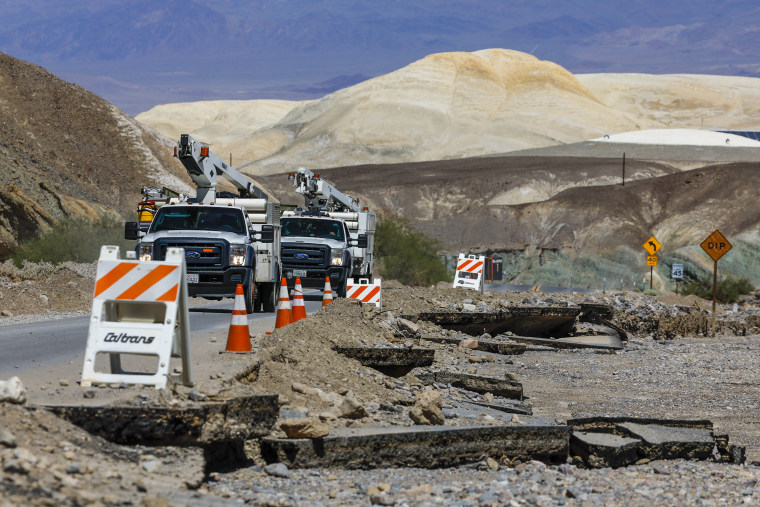Tall flowers, dead shrubs, ephemeral lake: Death Valley has become a picture of climate whiplash

Climate scientists have long predicted that global warming would both aggravate droughts in California’s inland deserts and also intensify bouts of rainfall. Death Valley locals say they’re watching that dynamic play out in real time. How desert plants, animals and local economies adapt to the changes in an environment that’s already one of the most extreme on Earth will determine the future of this symbol of resilience.
“It’s interesting to have a front row seat,” Donnelly said. “This is the signature of climate chaos.”
A 1-in-1,000-year storm — twice
Susan Sorrells, who owns the ecotourism town of Shoshone, which is near Death Valley National Park, said the area’s weather is “always a roller coaster ride.”
But that has been especially true over the last couple of years. In early 2022, Death Valley, like the rest of the American Southwest, remained mired in the driest period since the year 800. During the 22-year drought, soil moisture reached an all-time low. Plants were withering, including the creosote bush, which is known to live for thousands of years, thanks to deep roots that search for water and can survive on very little.
Its dieback during drought, then, was evidence of the weather’s severity.
“Desert shrubs are really tough and slow to die,” said Lynn Sweet, a research ecologist at the University of California Riverside. “But at some point, there is mortality.”
Then, in August of that year, a deluge arrived.
In several hours, Death Valley National Park received a record 1.7 inches of rain — about three-quarters of its typical annual total. The 1-in-1,000 year storm, as weather forecasters would later call it, washed out park roads, moved boulders and trapped cars in debris.
About a year later, remnants of Hurricane Hilary, a rare Pacific hurricane, dumped 2.2 inches of rain on the park — exceeding its typical annual rainfall in one day and setting a new 24-hour record.
“To have the worst drought in recorded history and the most precipitation in history, it’s clearly climate whiplash,” Donnelly said.

The rain closed the park, as well as Highway 127, which connects it to gateway communities but had become “a raging river,” Sorrells said.
She operates an ecotourism business with a 20-bed inn, hiking trails, a trading post, an RV park and the Crowbar Cafe and Saloon. For Sorrells, the situation was dire, as the highway’s reconstruction was slated to last through the winter and into spring, making the area nearly impossible to access throughout its busy season.
“We have a local joke: We make all our money from October through the end of April, and then we lose it from May through September,” she said.
The community rallied together and pushed state leaders to speed up the project, Sorrells said. The park partially reopened in October, and the highway in January.
Then things took a fascinating turn.
Spring wildflowers, which germinated in the fall, survived a warm winter, when freezing temperatures would typically knock them back down, according to Donnelly. And in February, a multiday atmospheric river storm system brought another deluge.
The wildflowers “lasted long enough for the atmospheric river to recharge them with all this rain,” Donnelly said. “Now, they’re growing in a very unusual way. They’re much taller than normal, much thicker-stemmed, very robust wildflowers.”
There was also enough water to revive Lake Manly, an ancient lakebed usually filled with dust.
For the first time, the National Park Service announced in February that it would allow kayakers to paddle on the lake, which was as deep as 3 feet, according to NASA.
 Print
Print




